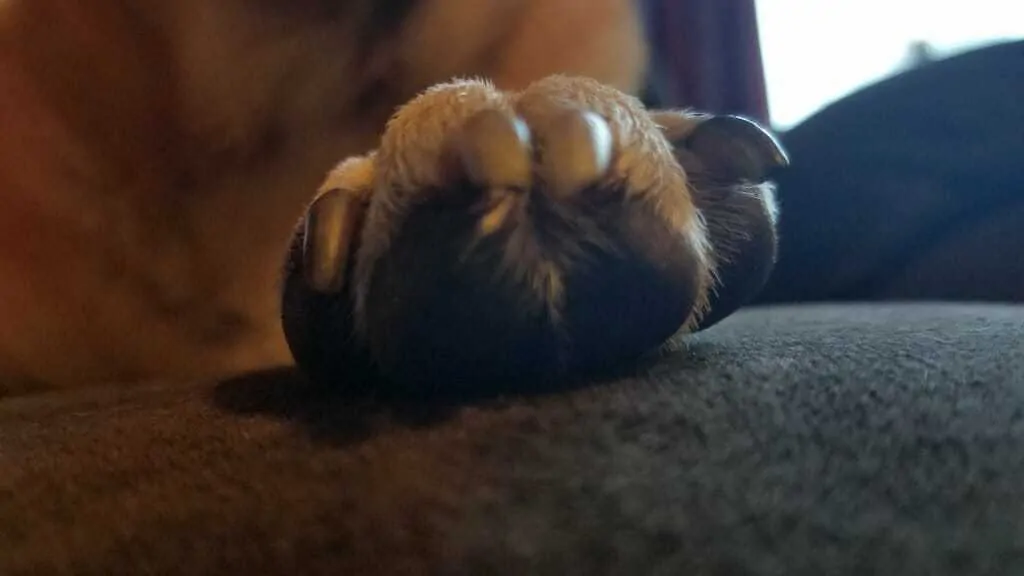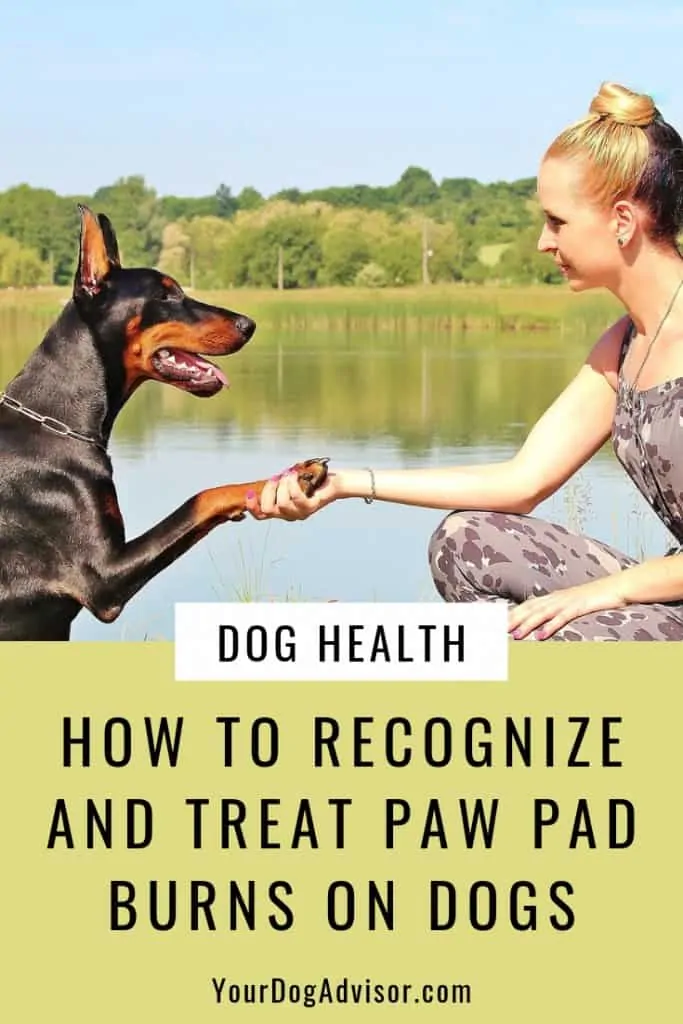As temperatures continue to rise this summer, there are a number of harmful conditions your dog is exposed to that typically aren’t an issue any other time of the year. With one of these being paw pad burns, it’s essential to know how to recognize the signs that your pup is suffering so you can treat them and assess whether they need immediate veterinary assistance. Here’s everything you need to know.
Contents
What Are Paw Pads
Paw pads are the rough cushions on the bottom of your pup’s paws, also known as foot pads. They’re made of tough fatty tissue and are considered to be the thickest part of the dog’s body. Designed to withstand the pressure associated with running around outdoors, your dog’s paw pads are like their very own personalized sneakers. While paw pads can often withstand harsh temperatures, they aren’t resistant to burns under certain conditions.
View of healthy dog paw pads from the front. Notice how there is no redness and the hair is growing between the pads in order to offer more protection from hot surfaces.
Causes Of Paw Pad Burns
Some dogs will suffer from paw pad burns if they walk through certain irritating chemicals or get caught in a fire, but the most common cause of this condition is walking your pup on hot surfaces. While dogs who are used to being outside can develop a tolerance for standing on warmer pavement, they can still be at risk when the temperatures heat up. Dogs who spend most of their time indoors are especially at risk over the summer and should avoid the pavement altogether.
Signs To Look Out For
One of the most obvious signs that your dog is suffering from paw pad burns is that they’re having trouble walking or flat out refusing to be on their feet. This can also be an indication that your pup is tired or has a leg injury, so here are some other symptoms associated with foot pad burns:
- Constant licking or chewing of their paws
- Limping
- Darker paw pads
- Redness in between paw pads
- Blistering
- Bleeding
- Missing parts of the pad
If your dog is demonstrating any of these symptoms, it’s essential to assess the damage and take immediate action.
Another example of healthy dog paw pads. While there is a pinkish hue to them, they are not injured or burned. Dog paws range in color from white to black and everything in between. Multi-colored paws are common and they should feel like rough leather.
What To Do Immediately After Noticing Paw Pad Burns
Upon noticing signs that your dog’s paw pads have been burned, immediately run them under cold water for 10 to 30 minutes. If all of their paws have been affected, you may want to run a cold bath. A damp cloth can be used if your pup is refusing to keep their paws in the water. Do not apply ice, as this can cause more damage to their injury!
The next actions you take depends on the severity of the burns.
First-Degree Burns
First-degree paw pad burns will appear slightly red, dry, and swollen but clearly only caused damage to the top layer of the skin. They might be tender to the touch, but won’t cause your dog more than mild discomfort and can be treated from home. Gently pat their paws dry after they’ve been sufficiently run under cold water. Be careful not to rub them while drying. You may want to consider applying an ointment or cream to the paw pads in order to prevent infection and promote faster healing.
Second And Third Degree Burns
If the burns seem to have reached the deeper layers of the skin, then you will need to see a veterinarian right away. You can recognize second and third degree burns by the appearance of blisters, extreme redness, and swelling. Third-degree burns will often damage the nerve endings, so your dog might not show signs of being in any pain. This, however, does not mean that the injury isn’t significant. After running your dogs paws under cold water, wrap them in a damp cloth or bandage and take them to an emergency veterinary clinic right away.
This pup’s paw was bandaged after suffering from a paw pad injury by a veterinarian.
How The Vet Will Treat Your Dog’s Paw Pad Burns
Your veterinarian will likely apply an ointment to your pup’s burns, start them on an antibiotic, and wrap their paws. The wounds should be cleaned and re-wrapped daily to avoid infection at the vet’s direction. If the burns are severe enough that pieces of the paw pads are torn, the vet may choose to stitch up the area as well.
At home, the healing process may be long and tedious. Your dog may want to be on their feet, but it’s important that they rest and stay off them. They may also be inclined to lick their wounds and pull at their bandages, but this can lead to infection and further injuries. For this reason, your dog may require a recovery collar and a lot of monitoring until their wounds have fully healed.
Home Remedies To Consider
Severe paw pad burns always require an immediate trip to the vet, but mild first degree burns can be treated with a number of home remedies. While aloe vera is a common go-to burn treatment for pups, it’s important to know that aloe is considered a potentially toxic plant for dogs and cats according to the ASPCA. If your dog is likely to like their wounds, consider one of these other home remedies that promote healing instead.
Witch Hazel
As a natural anti-inflammatory, witch hazel can be applied to your dog’s paw pads to reduce swelling and discomfort. It should be applied before bandaging the paw and re-applied each time the bandage is changed.
Antibiotic Ointment
Mild burns tend to dry out the paws. An antibiotic ointment or spray like Bacitracin or A&D Ointment will prevent this as well as ward off infection.
Olive Oil
If you find yourself without witch hazel or an antibiotic ointment at home, olive oil can be used to moisten the paw pads. While it won’t promote healing, it will prevent the paws from drying out and leading to further injuries.
Socks
If you don’t have bandages at your house and your pup won’t stop licking off the ointment, putting clean socks on them can help. They will ensure the ointment stays put and prevent dirt or bacteria from getting in the wound while they walk around. The socks will also act as an added comfort if your dog is in any discomfort.
How To Prevent Paw Pad Burns
The best thing you can do for your dog this summer is to learn how to prevent paw pad burns. If you can, avoid walking your dog on concrete for long periods of time. Be aware that flat surfaces like tennis courts are often significantly hotter than sidewalks or streets. When in doubt, rest the back of your hand on the surface for a few seconds to test the temperature. If it’s uncomfortable to keep your hand there after 10 or 15 seconds, then consider carrying your dog or taking a different route.
If you live in a city that offers few shaded or grassy areas, go for shorter walks on hot days or limit longer walks to the early morning and evening hours. Encourage your dog to be active in other ways by playing with them inside or taking them to a grassy park. If you have a short-nosed dog that is prone to breathing issues such as a pug or English bulldog, this will help to prevent heatstroke as well.
This dog wears a cone to prevent him from biting and pulling at his bandages, causing further injuries.
Wearing dog shoes can be a great way to protect your pup’s feet as well by providing extra protection for their paws. If your dog has experienced severe paw pad burns in the past, wearing shoes outside can give them the extra cushioning they need to reduce any discomfort. As an extra bonus, they also keep your dog’s paws clean so less dirt gets tracked into your house and they look adorable.
The paws can also be conditioned to withstand warmer surfaces. By walking your dog on concrete all year round, they will develop a thicker paw pad that is more resistant to the heat during the summer. Burns are more likely to occur is the dog is more accustomed to grass surfaces or being indoors. If your dog tends to have long hair between their paw pads, allow it to grow in as this can offer further protection from hot surfaces.
Conclusion
While the summer months offer the opportunity for extra playtime for our pups, it’s important as a dog owner to be aware of the possible dangers the added heat can create. Ensure your walks don’t lead to disaster by taking the necessary steps to avoid paw pad burns.

Jen Jones is a professional dog trainer and behavior specialist with more than 25 years of experience. As the founder of ‘Your Dog Advisor’ and the ‘Canine Connection’ rehabilitation center, she applies a holistic, empathetic approach, aiming to address root causes rather than merely treating symptoms.
Well known for her intuitive and compassionate approach, Jen adopts scientifically-proven, reward-based methods, encouraging positive reinforcement over punishment. Jen specializes in obedience training, behavior modification, and puppy socialization. Her innovative methods, particularly in addressing anxiety and aggression issues, have been widely recognized. Jen has worked with many of the world’s leading dog behaviorists and in her free time volunteers with local animal shelters and rescue groups.




